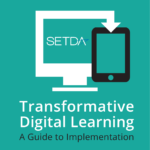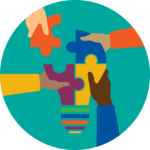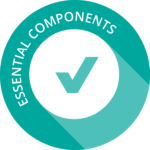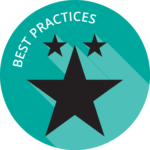Table of Contents
Planning
-
Overview
 Digital learning is no longer a specialty area. Increasingly, leaders across state and district agencies in a variety of roles have shifted towards the use of technology as a primary tool for teaching and learning. Consequently, districts are moving away from technology planning as a stand-alone activity in favor of more comprehensive planning efforts that include technology tools and resources as one overarching component of achieving school-wide goals. In this integrated approach, districts carefully analyze all applications of technology across the entire school before making investments in devices, infrastructure, digital learning resources or professional development.
Comprehensive planning requires a collaborative leadership approach that starts with developing a shared vision on how digital learning tools and resources support learning; seeking input from a variety of internal and external stakeholders; communicating with all stakeholders to encourage buy-in; and using and understanding research and data to support plan goals and objectives. Other key areas to consider in the planning process include operational considerations, including budget, procurement, interoperability; student data privacy; infrastructure needs, including devices and connectivity; as well as professional development.
Digital learning is no longer a specialty area. Increasingly, leaders across state and district agencies in a variety of roles have shifted towards the use of technology as a primary tool for teaching and learning. Consequently, districts are moving away from technology planning as a stand-alone activity in favor of more comprehensive planning efforts that include technology tools and resources as one overarching component of achieving school-wide goals. In this integrated approach, districts carefully analyze all applications of technology across the entire school before making investments in devices, infrastructure, digital learning resources or professional development.
Comprehensive planning requires a collaborative leadership approach that starts with developing a shared vision on how digital learning tools and resources support learning; seeking input from a variety of internal and external stakeholders; communicating with all stakeholders to encourage buy-in; and using and understanding research and data to support plan goals and objectives. Other key areas to consider in the planning process include operational considerations, including budget, procurement, interoperability; student data privacy; infrastructure needs, including devices and connectivity; as well as professional development.
E-Rate Technology Planning Requirements
As part of E-rate Modernization, the FCC eliminated the program’s technology planning requirement. Technology planning is still expected, but submitting and certifying technology plans is no longer a mandate. This shift in E-Rate requirements does not minimize the importance of planning for technology infrastructure. E-rate Modernization order. -
Digital Transformation
Technology is an essential component of learning today. With digital applications, tools and resources, students can create content, interact with experts, collaborate with peers and participate in simulation activities. Personalized learning experiences put students at the center of learning and empower students to take control of their own learning through flexibility and choice. The Every Student Succeeds Act (ESSA) acknowledges technology’s role in transforming learning and includes definitions for digital learning and blended learning, and references technology throughout the legislation. In the Non-Regulatory Guidance Student Support and Academic Enrichment Grants publication provides an overview of activities LEAs may consider as they prepare for implementation of the effective use of technology (ESEA Section 4109). Specific activities include: supporting high-quality professional development for educators, school leaders, and administrators to personalize learning and improve academic achievement; building technological capacity and infrastructure; carrying out innovative blended learning projects; providing students in rural, remote, and underserved areas with the resources to benefit from high-quality digital learning opportunities; and delivering specialized or rigorous academic courses and curricula using technology, including digital learning technologies. Similarly, the National Education Technology Plan (NETP) calls for a “revolutionary transformation rather than evolutionary tinkering” in education and recognizes that we must leverage technology to provide engaging and powerful learning experiences for all students. Technology offers all students – urban, rural, low-income, ESL, special needs, high achieving – the opportunity to engage in dynamic learning activities. Education leaders at the federal, state, and local level have the opportunity to provide leadership to ensure that all students have personalized, engaging learning experiences.Key Components
- Policies: In every state that has made a big push for the use of digital content in schools, legislators updated how their states legally define “textbook” and “instructional materials”
- Leadership: State and local leadership buy-in. The most critical part of a successful digital learning transformation state and local leadership buy-in. Leaders can communicate the vision to multiple stakeholders and ensure the appropriate resources are in place to carry it out.
- Sustainable Funding: States and districts need to ensure sustainable funding for devices, infrastructure and digital instructional materials and resources.
Resources
- The Accessibility of Learning Content for All Students, Including Students with Disabilities, Must Be Addressed in the Shift to Digital Instructional Materials
- CDWG’s How to Transition from a Print to Digital Curriculum (sponsored resource)
- Out of Print: Reimagining the K-12 Textbook in a Digital Age
- Curriculum Associates’ Guide to Purchasing EdTech the Right Way
- Ensuring the Quality of Digital Content for Learning
-
Collaborative Leadership
 Digital learning is no longer a specialty area. Increasingly, leaders across state and district agencies in a variety of roles have shifted towards the use of technology as a primary tool for teaching and learning. Organizing stakeholders for planning means determining early in the process who will have the authority and accountability to carry out the plan, who may have an interest in the outcome of the plan, and who can have influence in ensuring the plan is a success and then inviting representatives from those groups. It is critical that leaders across all areas are regularly engaged in collaborative planning discussions so that all leaders understand the district and school goals and the capacity to achieve those goals. This is especially true for academic, instructional, assessment and technology leaders. Looking across the state or district agencies, there are many leaders who are or should be involved in discussions and planning around digital learning:
Digital learning is no longer a specialty area. Increasingly, leaders across state and district agencies in a variety of roles have shifted towards the use of technology as a primary tool for teaching and learning. Organizing stakeholders for planning means determining early in the process who will have the authority and accountability to carry out the plan, who may have an interest in the outcome of the plan, and who can have influence in ensuring the plan is a success and then inviting representatives from those groups. It is critical that leaders across all areas are regularly engaged in collaborative planning discussions so that all leaders understand the district and school goals and the capacity to achieve those goals. This is especially true for academic, instructional, assessment and technology leaders. Looking across the state or district agencies, there are many leaders who are or should be involved in discussions and planning around digital learning:
- Chief Education Officer / Superintendent
- Chief Academic Officer or other Instructional Leaders
- Instructional Materials Leader
- Library Media Specialists
- Assessment Leader
- Digital Learning Leader
- Chief Technology Officer or other Technology Leader (Infrastructure, E-rate)
- Chief Financial Officer or other Business Leader
- Special Education Leader
- Title I/II/III Leaders
- Career Technical Education Leaders
- Professional Learning Leader
Key Components of Collaborative Leadership (Adapted from the NETP 2017)
- Develop a shared vision for how technology can support learning
- Seek input from a diverse team of stakeholders to adopt and communicate clear goals for teaching, leading, and learning that are facilitated by technology
- Communicate with all stakeholders by using appropriate media and technology tools and establish effective feedback loops
- Ensure that practitioners at the school and district level use and understand research
Tech Support
An important stakeholder group to include early in the planning process is the technology support team. Tech support teams interact across multiple departments and can provide valuable insight into the planning, implementation, and refinement process.Facilitator Guide
 The Facilitator Guide – Collaborative Leadership provides education leaders with the information and resources they need to conduct a professional learning session. Participants will:
The Facilitator Guide – Collaborative Leadership provides education leaders with the information and resources they need to conduct a professional learning session. Participants will:
- Review the key components for collaborative leadership to support digital learning
- Learn about strategic planning tools for digital learning implementation
- Think about who the appropriate education leaders are in your state/district to coordinate the strategic planning process
- Discuss with colleagues what teaching and learning would look like if leaders from across disciplines collaborated on aligned digital learning solutions
- Discuss some of the key policies and practices that impact and support learning in the digital age
- Develop and maintain relationships with other district and state leaders
-
Shared Vision
As district and school leaders initiate the planning process, a shared vision serves as a firm compass point for how technology will support teaching and learning goals. Unlike a consensus in which everyone agrees, developing a shared vision represents buy-in from all stakeholders and reflects efforts to involve the right people at the right times. One way to achieve a shared vision is to use clear language in all aspects of the process. Districts that have carefully defined target audiences, goals, methods, timelines, responsibilities and outcomes enjoy less confusion because of better communication.Key Steps
- Create a planning and leadership site-based decision making team representing a variety of education stakeholders from multiple programs and diverse backgrounds.
- Establish an overview and a shared mission and/or vision statement that addresses what the district needs and what impact digital learning tools and resources are expected to have on learning.
- Ensure that the vision/mission is communicated and that there is buy-in from educators, students, parents, business, and community.
- Leverage existing partnerships and initiatives.
- Research promising programs in your state and across the nation
Resource
-
Collaboration with External Stakeholders
As schools move towards digital learning environments, it is necessary to foster leadership beyond district and school leaders to support the transition. Inviting stakeholders to participate early in the planning process fosters collaboration among stakeholders. It is important to determine who will have the authority and accountability to carry out the plan, who has an interest in the outcome of the plan, and who can help ensure that the plan is a success. The relationship between the district and the school board is an essential component for success, especially when implementing digital learning. The National School Boards Association guide, On the Same Page 2.0 is intended to spark conversation and suggestions among stakeholders and emphasizes the importance of information flow for continuous improvement and ownership by all stakeholders. Often times states and districts involved community members in the planning process. -
Communication
Rollout can significantly impact the success of a program. Critical to any rollout is clear communication to all stakeholders including administrators, teachers, parents, students, funders and community leaders. Communications should be tailored to each audience and provided in a variety of ways such as press releases, workshops, email campaigns, community bulletins and webinars. When possible, meetings should be recorded and archived. Communications should include details regarding:- Program rationale and goals
- Policies
- Schedule and phases of deployment
- Support services
- Measures of success
From the Field
Indiana developed a Communications Launch Protocol that provides districts with communication tools so that they can broadcast information about a new initiative, upcoming PD opportunity, grant or resource. The protocol includes links to the state’s social media tools, websites, newsfeeds and education membership organizations. -
Research
It is important that educators at the state, district, and school level use and understand data and research. The following examples are research based planning tools for the implementation of digital learning environments. International Society for Technology in Education ISTE Essential Conditions offers a research-backed framework to guide digital learning implementation. ISTE identifies 14 critical elements necessary to effectively leverage technology for learning.- Shared vision
- Empowered leaders
- Implementation planning
- Consistent and adequate funding
- Equitable Access
- Skilled personnel
- Ongoing professional learning
- Technical support
- Curriculum framework
- Student-centered learning
- Assessment and evaluation
- Engaged communities
- Support policies
- Supportive external context
-
Digital Learning Plans
Strategic planning is essential to achieve our goals for learning in the digital age. Strategic planning embraces the general structure of any thoughtful, systematic process. That is, stakeholders begin with a gap analysis or needs assessment, then define goals, activities, timelines, and outcomes to address the needs and finally evaluate whether needs were met.Conduct a Needs Assessment
As part of the strategic planning process, states and districts should conduct a needs assessment, environmental scan, or evaluation of conditions for success. This leads to action planning that defines the audience served, professional development and resources needed to carry out the technology plan.Define Goals, Objectives and Activities
- Develop specific goals, objectives, and activities/strategies that transform teaching and learning and align to the district’s strategic plan and results of needs assessments
- Ensure that state and federal requirements and expectations are included in goals, objectives, and strategies.
- Include a timeline to help ensure that goals and objectives are met in a reasonable time frame
- Communicate with education stakeholders the timeline for implementation and expected results
- Identify the person and/or departments responsible for each activity
- Include a process for aligning activities/strategies with curriculum standards
- Include well-defined strategies for evaluation, assessment, and accountability
- Incorporate new instructional approaches and communication models in the plan
Conduct an Evaluation
- Develop a process for measuring the effectiveness of the plan based upon metrics that were included in the goals, objectives, and activities
- Include dedicated time for planning, collaboration, communication, feedback, and adjustment during the plan’s implementation
- Determine formative and summative methods for evaluation, including online measures to document progress and achievements
- Infrastructure
- Devices
- Technology & Hardware
- Platforms
- 1:1
- Funding
- Human Capacity/Professional Learning
- Content, Instruction, Assessment
- Virtual Courses
- Local innovations
- Regional/state support
- Communication
- Procurement
- Empowering Leadership
- Data and Privacy
Facilitator Guide
 The Facilitator Guide – Essential Components provides education leaders with the information and resources they need to conduct a professional learning session. Participants will:
The Facilitator Guide – Essential Components provides education leaders with the information and resources they need to conduct a professional learning session. Participants will:
- Hear from your colleagues on how technology supports their student learning goals.
- Explore federal policy shifts around transforming learning in the digital age.
- Examine exemplar digital learning plans and identify common components across the plans.
- Create a digital learning plan that can be used as model in your state or district.
- Develop and maintain relationships with other state leaders.
Key Questions
- Where is your state/district in the development of a digital learning plan?
- Do you plan to develop a digital learning plan in the next 6 months? Next 12 months?
- What factors hinder your planning process? Leadership? Staff time?
- How are you considering equity issues across your state/district?
- What funding options are you considering?
- Is your state/district considering competency-based education?
- How are you addressing personalized learning in your state/district?
-
Best Practices
The following section highlights select states with digital learning plans and provides a brief overview of each of these plans:Indiana
The Indiana Tech Plan provides a snapshot of where each corporation (district) is with regard to infrastructure and the integration of student technology in learning. Each district completes an annual technology planning survey. Key components of the survey include: technology integration; infrastructure; platforms; virtual courses professional development; 1:1 status; devices; and funding. Indiana publishes the results of the survey at Tech Plan Maps. Users can select a corporation to see a synopsis of their technology planning survey.North Carolina
The North Carolina Digital Learning Plan creates a long-term strategy that sets directions and priorities, supports innovation, and provides resources to enable educators and students to benefit fully from teaching and learning in the digital age. The plan also provides recommendations for state actions that will guide and support K-12 schools in this process. Key components of the plan are: technology infrastructure and devices; human capacity; content; instruction and assessment; local digital learning innovations; policy and funding; and regional and state support structures.Utah
The Utah State Board of Education (USBE), Utah Education and Telehealth Network (UETN), the legislature and local school systems worked together to best leverage the power of technology for learning. Utah’s Master Plan: Essential Elements for Technology Powered Learning provides a framework for implementing digital learning. Each element of the plan includes the rationale, state responsibilities and district responsibilities. Key sections are: professional learning, communication, infrastructure; digital devices, content and software; technical support; procurement; and funding.Wisconsin
Wisconsin developed a comprehensive digital learning plan for PK-12. Wisconsin adopted the Future Ready Framework as a way to organize key priorities and planning tools for districts. The Future Ready vision focuses on equitable, personalized, applied, and engaged digital learning for all students. The state encourages districts to consider the following areas when implementing their vision: instruction, learning and assessment; empowering, innovative leadership; technology & hardware; professional learning and building capacity; and data and privacy.Column contentFacilitator Guide
 The Facilitator Guide – Best Practices provides education leaders with the information and resources they need to conduct a professional learning session. Participants will:
The Facilitator Guide – Best Practices provides education leaders with the information and resources they need to conduct a professional learning session. Participants will:
- Learn about best practices for learning in the digital age
- Review scenarios and discuss issues of transformative digital learning opportunities, connectivity, equity and professional learning with your colleagues
- Use rapid cycle evaluation for digital instructional materials
- Collaborate with colleagues regarding best practices to ensure digital learning in action
- Develop and maintain relationships with other district and state leaders
-
Facilitator Guides
These guides provide facilitators with step by step activities, with suggested times for each activity, as well as narrative content and resources to support the topic. The guides are accompanied by a presentation slide deck for use during the workshop. They also include a link to a logistics spreadsheet to help facilitators plan the workshop. Logistics include recommendations for audio visual, catering, registration and outreach. The facilitators guide can be used in their current format or they are easily customizable to meet your needs.Slide Decks

